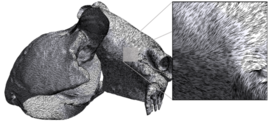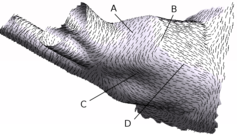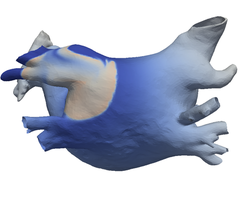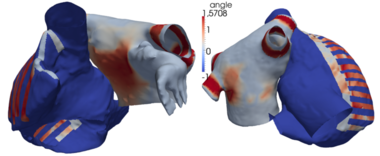Simon Labarthe
Research
I'm currently working in the modelling of the intestinal microbioty in the INRA center of Jouy-en-Josas (MIA). I am interested in bacterial population dynamics and in physiological interactions between the host and the microbiota.
This page deals with the research axes that I could follow during my PhD.
This page deals with the research axes that I could follow during my PhD.
Mathematics
Keywords : asymptotic analysis, bilayer model, homogenization, model simplification, scientific computing
Mathematical bilayer model of cardiac electrophysiology
Asymptotic methods are used to derive a bilayer surface model that allows to simulate three-dimensional phenomena for a bi-dimensional computational load, and to investigate 3D atrial patterns involved in atrial arrhythmia such as electrical dissociation or transmural heterogeneities. The convergence of the bilayer model is proved with energy estimate technics, and an optimization strategy to improve the model outside the asymptotic regime is formalised.
Homogenization with non linear effects
The usual bidomain model comes from an homogenization step that takes into account the microscopic electrical coupling to derive the macroscopic diffusion tensor. The usual hypothesis is that the gap junctions that insure the cell-to-cell coupling can be consider as passive resistors. However, new microbiological works showed that the gap junctions have a complex non-linear dynamics in time that depends on the cell-to-cell potential steps. I aimed to construct a macroscopic model of cardiac tissues that includes the non-linear gap junctional coupling by using homogeneisation tools.
Applications
Keywords : bilayer atrial model, accurate human atrial model, arrhythmogenic scenarii, personalization
Fibres direction
I've developped during my PhD thesis a rule-based method to semi-automatically construct fibre direction on atria that involves the following steps:
- Image acquisition, automatic segmentation of atria and mesh generation.
- Manual segmentation of the mesh in tubular-like sub-structures.
- Semi-automatic construction of the circunferentially oriented fibres on this sub-structures.
- Inpainting algorithm to complete the structure on the whole geometry.

|
| A biatrial model of fibre orientation. |
Pulmonary veins modeling
I've focused a part of my work on pulmonary veins models. My goal was to propose arythmogenic scenarii, mainly based on fibre orientation, and to assess them with computational simulations.

|
 |
| Left: heterogeneity of fibre orientation in the left superior pulmonary vein. Right: a reentry triggered by this fibre orientation scenario. | |
Multi-layer atrial models
I've contributed to develop a bi-layer atrial model that allows the inclusions of transmural heterogeneities while keeping the small comutational costs of a two dimensional model. This contribution comprises a mathematical analysis of the bilayer model in an asymptotic regime of wanishing thickness, and the construction of a physiological bi-layer model of the atria.
This bi-layer model can be a good tool for atrial modeling.

|
| Angle difference of fibre orientation between the epicardial and endocardial layers. |
Investigation of transmural effects during atrial arrhythmia
The bilayer model is specially designed to explore the three dimensional effects in the thin atrial tissues during several seconds, which is the significant time scales for arrhythmic issues.
I explored the influence of transmural heterogeneities such as transmural fibrosis on the perpetuation of a rotor-like atrial arrhythmia, and I assessed the respective influence of several ablation scenarii.
Conclusion
I tried to keep effective two sides of my work. 1) Take advantages of my mathematical background to develop the existing mathematical models of cardiac electrical propagation. 2) Make those mathematical improvment usefull for fundamental or clinical cardiac research.
Contact
INRA Domaine de Vilvert
78352 JOUY-EN-JOSAS CEDEX
Phone : +33 (0)1 34 65 22 36
Links
MIA Jouy-en-Josas
Applied mathematics and informatics for biology and agronomy
CARMEN Research Team
Modeling for cardiac electrophysiology
IMB
Institut de Mathematiques de Bordeaux
Universite Bordeaux Segalen
The biology and health hub of the Bordeaux University
Inria
Inria Research Center of Bordeaux
INRA Domaine de Vilvert
78352 JOUY-EN-JOSAS CEDEX
Phone : +33 (0)1 34 65 22 36
Links
MIA Jouy-en-Josas
Applied mathematics and informatics for biology and agronomy
CARMEN Research Team
Modeling for cardiac electrophysiology
IMB
Institut de Mathematiques de Bordeaux
Universite Bordeaux Segalen
The biology and health hub of the Bordeaux University
Inria
Inria Research Center of Bordeaux


